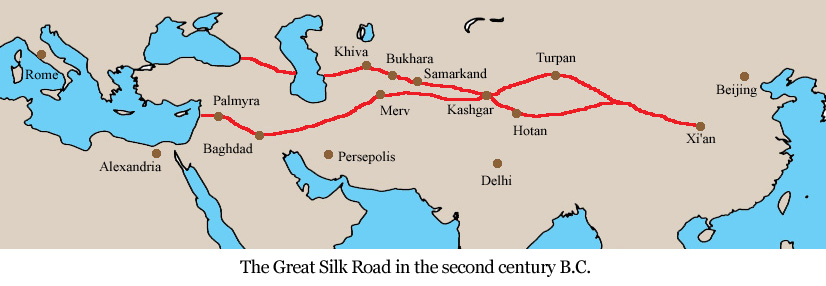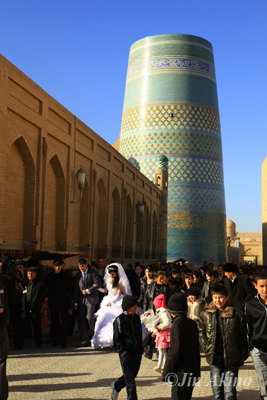Khiva is one of old cities of ancient Khorezm, the pearl of eastern middle age architecture.
Khiva lies 25 kilometers south of present-day Urgench.
According to the legends Khiva was founded by a son of Noah, Shem when he dug a well in the middle of the desert. People who drank water of that well exclaimed as “Khey-vakh” which roughly means “sweet water.” And this area became a caravan destination because of merchants’ frequent visit. For the next thousand years the area was inhabited by several tribes that used the Amudarya river for irrigated agriculture.
According to the archeologists Khiva was founded in the 5th or 4th centuries B.C. As the first major structures were built, the city became known as trading post on the Silk Road.
First written sources date from the 10th century. The Arab traveler Al-Istarkhiy mentioned Khiva among the 30 important cities in Khorezm. The Arab geographer Ibn Batuta visited Khiva in the 14th century. He praised the ruler’s untiring care of law, order, and reported that the city was so full of people that it was almost impossible to find one’s way in a crowd.
 Khiva had a water supply directly from the Amudarya river by Khekanik canal (present-day Palvanyap). Trade and social life was much flourished in the city at that time. And it came to a sudden end after Gengizkhan’s army destroyed the area. Khiva gained its independence again developed for the next several centuries. Major construction was reconstructed again and it continued its active role on the Silk Road trade with producing much precious goods.
Khiva had a water supply directly from the Amudarya river by Khekanik canal (present-day Palvanyap). Trade and social life was much flourished in the city at that time. And it came to a sudden end after Gengizkhan’s army destroyed the area. Khiva gained its independence again developed for the next several centuries. Major construction was reconstructed again and it continued its active role on the Silk Road trade with producing much precious goods.
And in the early 16th century it became capital of Khiva khanate, one of the Uzbek khanates. The majority of Khiva’s immense architectural projects began and the city established itself as a center of power in the region. But this development didn’t last after the campaign Iranian ruler Nadirshakh in 1740. The city was completely destroyed by his army and the country became its colony. After Iran the Turkman leaders took the power in the country for several years. Eventually after long battles for the power the Kungrad dynasty of Khiva khans took the power until 1920.
 The city was divided into two parts in XIX century: Ichan Kala (inner city) with 10 meters high wall and Dishan Kala (outer city). At the same time the entire city was surrounded by several settlements and villages.
The city was divided into two parts in XIX century: Ichan Kala (inner city) with 10 meters high wall and Dishan Kala (outer city). At the same time the entire city was surrounded by several settlements and villages.
Ichan Kala has 6 to 8 meters high, 6 to 7 meters wide and 2,2 kilometers long city wall. And It covers 26 hectares area of Khiva. As other fortresses in Central Asia the city walls were built out of sun-backed bricks. The city walls were destroyed several times but they were always reconstructed. The city rectangular in shape 650 meters by 400 meters and it has four gates facing to four sides of the world.
Ichan Kala was a site for the Khan’s palace. High officials, clergy and rich merchants lived there. The ordinary people, small merchants and craftsmen lived in Dishan Kala.
Dishan Kala – the outer city was built in 1842 by the order of Allakulikhan by volunteer workers in thirty days. It was was one of the government taxes that every citizen of the khanate had to work for the government free of charge for twelve days. This was called beghar. So 200,000 people constructed the walls of outer city. A famous historian of Khiva Agakhiy gives evidence about the construction in one of his works.
The outer city has 6,2 kilometers long city wall with its ten gates; Khazarasp (known as Kuydavaza), Pishkanik, Angarik, Shikhla, Tazabagh. Shakhimardan, Dashyak, Gadaylar, Kushadarvaza and Gandimiyan.
 And there are several summer residences and gardens that belonged to the royal families as well. Such as Rafanic, Nurllabek and Nurullaboy. After the outer city walls were built the city was divided into two fortresses and it expended.
And there are several summer residences and gardens that belonged to the royal families as well. Such as Rafanic, Nurllabek and Nurullaboy. After the outer city walls were built the city was divided into two fortresses and it expended.
There were 33 settlements in Ichan Kala and 34 in Dishan Kala in 1920s. Each has its own name indicating the crafts of its population. There were 109 different streets, 79 mosques, 120 Quran schools and 64 medressahs in the city.
Khiva was located on the crossroad of The Great Silk Road as an important post that connected two powerful lands, China And Rome.
The old fortress of Khva became “Ichan Kala” state museum reserve. And the city was recognized as a World Heritage Site by UNESCO in 1990. There are 54 historical and architectural monuments in the city. The current population of the old city is 2600, and there are 360 houses. There are 40,000 precious exhibitions with more than 3000 years history in the Khiva “Ichan Kala” state museum reserve fund.